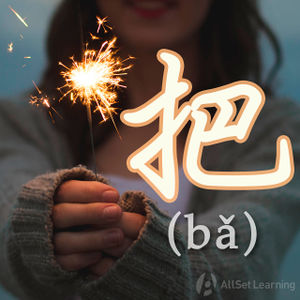Difference between revisions of "Verbs followed by "gei""
| Line 18: | Line 18: | ||
<div class="liju"> | <div class="liju"> | ||
| − | * 他 <em>送给</em> 了 我 一 束 花。 | + | * 他 <em>送给</em> 了 我 一 束 花。<span class="trans"> He gave me a bouquet of flowers. </span> |
| − | * 这 个 老板 <em>卖给</em> 了 我 一 条 死 鱼。 | + | * 这 个 老板 <em>卖给</em> 了 我 一 条 死 鱼。<span class="trans"> This boss bought me a dead fish. </span> |
| − | * 我 要 <em>还给</em> 你 三 十 块 钱。 | + | * 我 要 <em>还给</em> 你 三 十 块 钱。<span class="trans"> I need to return 30rmb to you. </span> |
| − | * 房东 <em>租给</em> 了 我 一 个 很 便宜 的 房子。 | + | * 房东 <em>租给</em> 了 我 一 个 很 便宜 的 房子。<span class="trans">The landlord rented a very cheap house to me. </span> |
| − | * 我 <em>借给</em> 了 他 一 本 书。 | + | * 我 <em>借给</em> 了 他 一 本 书。<span class="trans"> I lent him a book. </span> |
| − | * 我 要 糖,他 <em>递给</em> 了 我 一 瓶 盐。 | + | * 我 要 糖,他 <em>递给</em> 了 我 一 瓶 盐。<span class="trans"> I wanted sugar, he handed me a bottle of salt. </span> |
| − | * 姐姐 <em>分给</em> 了 我 一块 蛋糕。 | + | * 姐姐 <em>分给</em> 了 我 一块 蛋糕。<span class="trans"> Older sister gave me a piece of cake. </span> |
| − | * 老师 <em>传授给</em> 了 学生 很多 经验。 | + | * 老师 <em>传授给</em> 了 学生 很多 经验。<span class="trans"> The teacher passed on a lot of experience to us. </span> |
| − | * 我们 <em>献给</em> 了 老师 一 首 歌。 | + | * 我们 <em>献给</em> 了 老师 一 首 歌。<span class="trans"> We dedicated a song to the teacher. </span> |
| − | * 这些 校友 <em>捐给</em> 了 学校 二 十 万。 | + | * 这些 校友 <em>捐给</em> 了 学校 二 十 万。<span class="trans">These alumnus donated two hundred thousand to the school. </span> |
| − | * 主人 <em>赏给</em> 了 小狗 一 块 肉。 | + | * 主人 <em>赏给</em> 了 小狗 一 块 肉。<span class="trans"> The owner rewarded his dog with a piece of meat. </span> |
| − | * 一 个 小孩 <em>交给</em> 了 我 一 封 信。 | + | * 一 个 小孩 <em>交给</em> 了 我 一 封 信。<span class="trans"> A child gave me a letter. </span> |
</div> | </div> | ||
Revision as of 09:33, 5 December 2014
-
Level
-
Similar to
-
Used for
-
Keywords
Although it's standard practice to put a word or phrase that modifies a verb before the verb, there are, of course, exceptions. 给 (gěi) is one of those exceptions; it sometimes comes before the verb, and sometimes after. (For this reason, there is some academic debate over whether this 给 is actually a preposition or a type of verb, but we won't get into that....) This article is about when it comes after.
Contents
Basic Pattern
Structure
Note that the verbs that fit into this pattern are normally single-syllable verbs.
Subject + Verb + 给 + [Recipient] + Object
Examples
- 他 送给 了 我 一 束 花。 He gave me a bouquet of flowers.
- 这 个 老板 卖给 了 我 一 条 死 鱼。 This boss bought me a dead fish.
- 我 要 还给 你 三 十 块 钱。 I need to return 30rmb to you.
- 房东 租给 了 我 一 个 很 便宜 的 房子。The landlord rented a very cheap house to me.
- 我 借给 了 他 一 本 书。 I lent him a book.
- 我 要 糖,他 递给 了 我 一 瓶 盐。 I wanted sugar, he handed me a bottle of salt.
- 姐姐 分给 了 我 一块 蛋糕。 Older sister gave me a piece of cake.
- 老师 传授给 了 学生 很多 经验。 The teacher passed on a lot of experience to us.
- 我们 献给 了 老师 一 首 歌。 We dedicated a song to the teacher.
- 这些 校友 捐给 了 学校 二 十 万。These alumnus donated two hundred thousand to the school.
- 主人 赏给 了 小狗 一 块 肉。 The owner rewarded his dog with a piece of meat.
- 一 个 小孩 交给 了 我 一 封 信。 A child gave me a letter.
Pattern Using 把
Structure
Subject + 把 + Object + Verb + 给 + somebody
Examples
- 他 把 一 束 花 送给 了 我。
- 这 个 老板 把 一 条 死鱼 卖给 了 我。
- 房东 把 一 个 很 便宜 的 房子 租给 了 我。
- 我 把 一 本 书 借给 了 他。
- 我 要 糖,他 把 一 瓶 盐 递给 了 我。
- 姐姐 把 一 块 蛋糕 分给 了 我。
- 老师 把 很 多 经验 传授给 了 学生。
- 我们 把 一 首 歌 献给 了 老师。
- 这 些 校友 把 二 十 万 捐给 了 学校。
- 主人 把 一 块 肉 赏给 了 小狗。
- 一 个 小孩 把 一 封 信 交给 了 我。
Exception to the 把 Pattern: 嫁
Note that the verb 嫁 (jià) cannot fit into the 把 pattern above; it's an exception.
- 她 嫁给 了 一 个 有 钱 的 老头。
If you really really want to make a 把 sentence, though, you can do this:
- 她 的 爸爸 把 她 嫁给 了 一 个 有 钱 的 老头。
See also
Sources and further reading
Books
Dictionaries
- 现代汉语词典(第5版) (p. 464) →buy



